What's new - 2022
Learn about the latest features and enhancement.
December 2022 - Version 4.14.0
December 2022 - Version 4.14.0
Overview
- Wallet Connect has now been integrated to the Ledger Enterprise platform, opening up a whole world of possibilities in the Web3
- You can now interact with smart contracts on the Polygon network
Maximizing Web3 Access and User Security with WalletConnect and Ledger Enterprise Integration

Previously, accessing DApps and the web3 ecosystem required the app to be natively supported on Ledger Enterprise, or using the Contract Interaction panel, which is not easy to use for non tech-savvy users. To address this challenge, we have integrated WalletConnect into the Ledger Enterprise platform to empower users to easily interact with a growing ecosystem of DApps without the need for external gateways or technical knowledge.
Financial institutions can now access the web3 ecosystem with improved security: Any subsequent transactions will be securely signed by your Personal Security Device within Ledger Enterprise, with ClearSign available (see Supported ClearSign contracts & applications). This complements the existing features of Ledger Enterprise, such as the integration of DApps in the DApps catalog.
Users can now access the entire Web3 ecosystem and benefit, for instance, from yield generation DApps through various strategies. They can lend their assets on lending platforms to earn interest, borrow assets for leverage or hedging, or provide liquidity on decentralized exchanges to earn rewards. These and other yield generation strategies are now easily accessible through WalletConnect and the Ledger Enterprise platform.
Interact with Smart Contracts on Polygon network
This feature is currently available only on demand. Please contact your Technical Account Manager for more information.
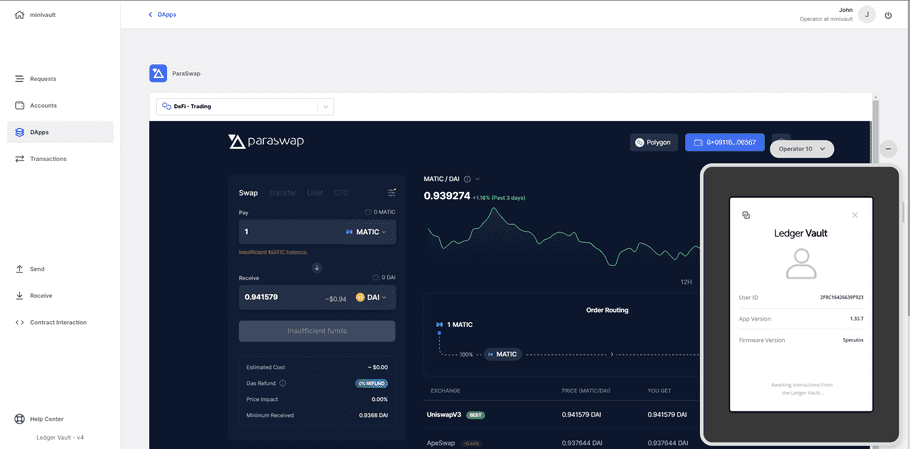
You can now interact with any smart contract based applications on Polygon, and benefit from the low fees of the network to optimize your web3 operations, whether it be DeFi or NFT. Ledger Enterprise provides the same level of support as on Ethereum:
- Administrators can configure smart contract enabled accounts on Polygon, and define a dedicated governance rule for interacting with web3 apps on Polygon.
- Operators can access Vault DApps on Polygon directly on their workspace, featuring Paraswap for now (and more to come).
- Operators can interact with any Polygon contract using the Contract Interaction panel - provided the contract has its ABI published on Polygonscan.
- Operators will be able to Clear Sign their Polygon smart contact interactions on Trusted Display for all supported contracts (see: Supported ClearSign contracts & applications ), bringing unparallelled security to web3 operations.
- All interactions with web3 apps on Polygon can be achieved through the Public API. Please refer to the documentation here: https://ledger-enterprise-api-portal.redoc.ly/openapi/le_api/tag/Transactions/ .
December 2022 - Version 4.13.0
December 2022 - Version 4.13.0
Hardware Operating System update
While this update to the OS running on Ledger Hardware wallets will show no visible changes to our end users, it will act as an important enabler to lay the groundwork for future exciting features. We’ll detail these new features more soon!
December 2022 - API Version 1.6.0
December 2022 - API Version 1.6.0
Stake directly via our API
It is now possible to stake directly via our API for the Polkadot network. You can see the detailed list of available endpoints here.
Smart contract interactions via API - New option: contract inputs in ABI format
- Reminder: The Ledger Enterprise API lets you interact with any smart contract on the Ethereum blockchain. The transaction creation & approval endpoints make it possible to trade on decentralized exchanges, deposit liquidity on DeFi protocols, mint or transfer NFTs programmatically and at scale, all while using Vault Ethereum accounts (other EVM networks will follow very soon).
- New option: We have added optional fields to our Create a transaction & Approve Transaction endpoints, to facilitate the creation & approval of smart contract interactions. API operators who do not wish to encode contract data inputs can now provide the contract ABI, and name the contract functions and arguments they wish to execute, following the ABI specification .
Note that an update of the Ledger Authentication Module (LAM) to the latest image version (1.6.0) is required to perform smart contract interactions with decoded contract inputs via the Ledger Enterprise API. See Step 3 of the LAM installation process: Get started with the Ledger Vault's API for information on where to update your LAM version.
For more information on how to conduct smart contract interactions on the Ledger Enterprise platform see this article: Smart Contract Interactions on the Vault.
API improvements:
- Transactions can now be searched by note title or content, using the label query param
- Transactions queried by API now include a block confirmation object to facilitate on-chain tracking
- Whitelists queried by API now include XRP tags
- We’ve improved the generation of fresh receiving addresses for UTXO-based coins
November 2022 - Version 4.12.0
November 2022 - Version 4.12.0
See and send your NFTs directly from the Vault
Although it is already possible to connect with Ledger Enterprise DApps to swap, stake, and visualize your NFT assets, we have decided to take this a step further by offering the ability to interact with your NFTs directly on your Vault accounts.
This applies to NFTs on the Ethereum blockchain, specifically ERC-721 and ERC-1155 tokens.
Note that other EVM networks will follow soon.
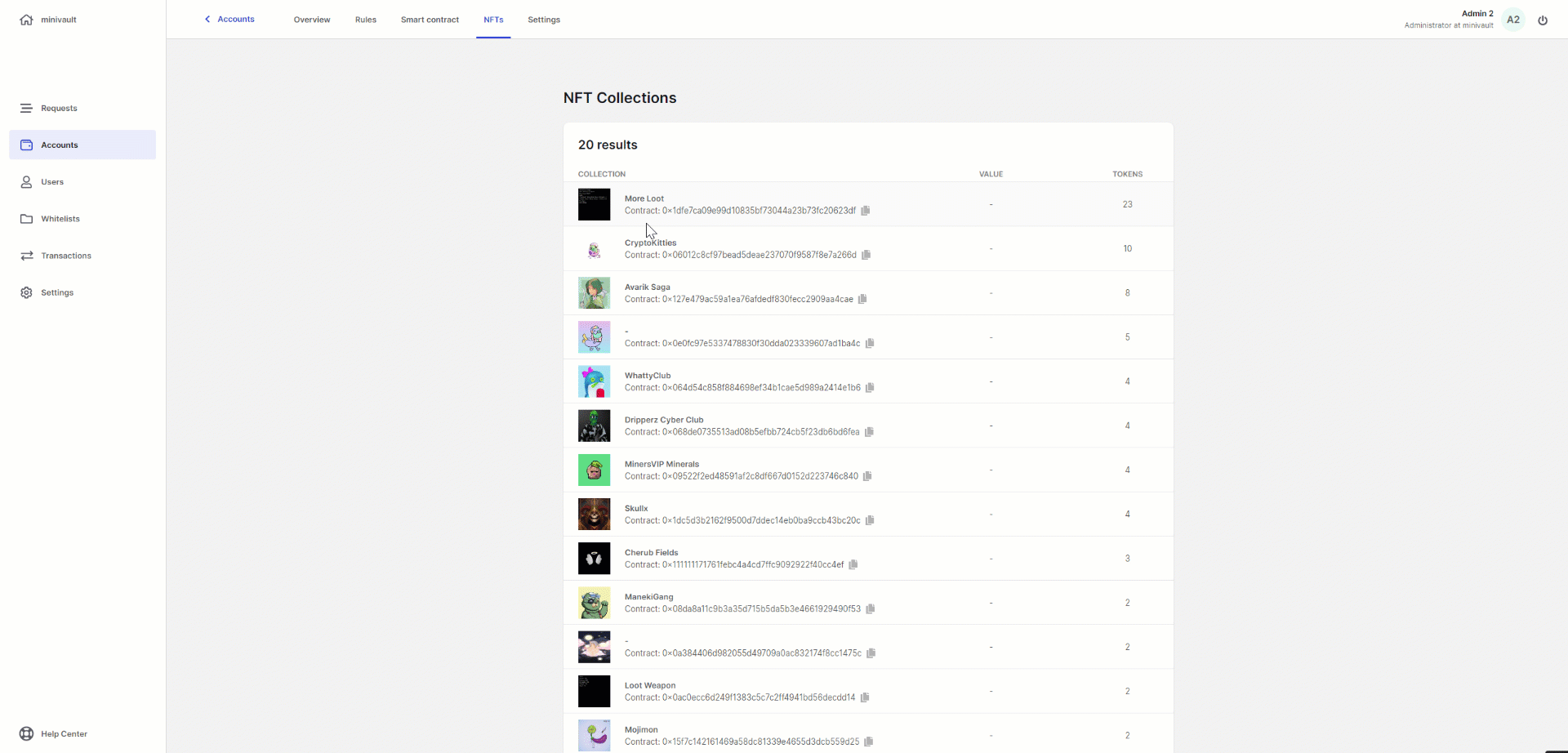
Find out more about how the feature works with these two articles:
- As an administrator , you’ll be able to simply toggle on or off the view of NFTs owned by an account in its settings. Find out exactly how to do so here: View NFTs on an ETH account .
- All operators listed in the Smart Contract rule of the account can send NFT tokens according to the steps outlined in the rule. This article outlines a step-by-step guide explaining the different steps of the send NFT operation: Send an NFT from the Account Gallery .
November 2022 - Versions 4.10.0 and 4.11.0
November 2022 - Versions 4.10.0 and 4.11.0
Improvements
Some changes were made behind the curtain to pave the way for future features, but there are no noticeable changes displayed for this release.
November 2022 - API update
November 2022 - API update
API whitelist field change
In the whitelist section, the field destination\tag_, which was an integer, has now become:
- destination_tags : array of integers
You can see the change in our API documentation here.
October 2022 - Version 4.9.0
October 2022 - Version 4.9.0
Overview
- You can now clearsign your smart contract interactions
- You can also interact with any Ethereum contract using our Contrat Interaction Panel
- Polygon Send & Receive is now available
- An update on the Polkadot network has been reflected in the Vault
Don’t trust, verify: ClearSign your interactions with smart contracts on Trusted Display
Ledger Enterprise is bringing unparallelled security to web3 operations. With ClearSign, users can now verify their interactions with smart contracts on the Trusted Display of their Personal Security Devices, effectively preventing them from blind signing these transactions. You can read more about blind-signing and the risks associated with it here.
When interacting with supported Ledger Enterprise ClearSign contracts, Operators are prompted to review the exact nature of their smart contract transaction on their device trusted display. Ledger Enterprise interprets contract interactions in an easily human-readable format, so Operators can ensure the transaction details match their intent before approving them.
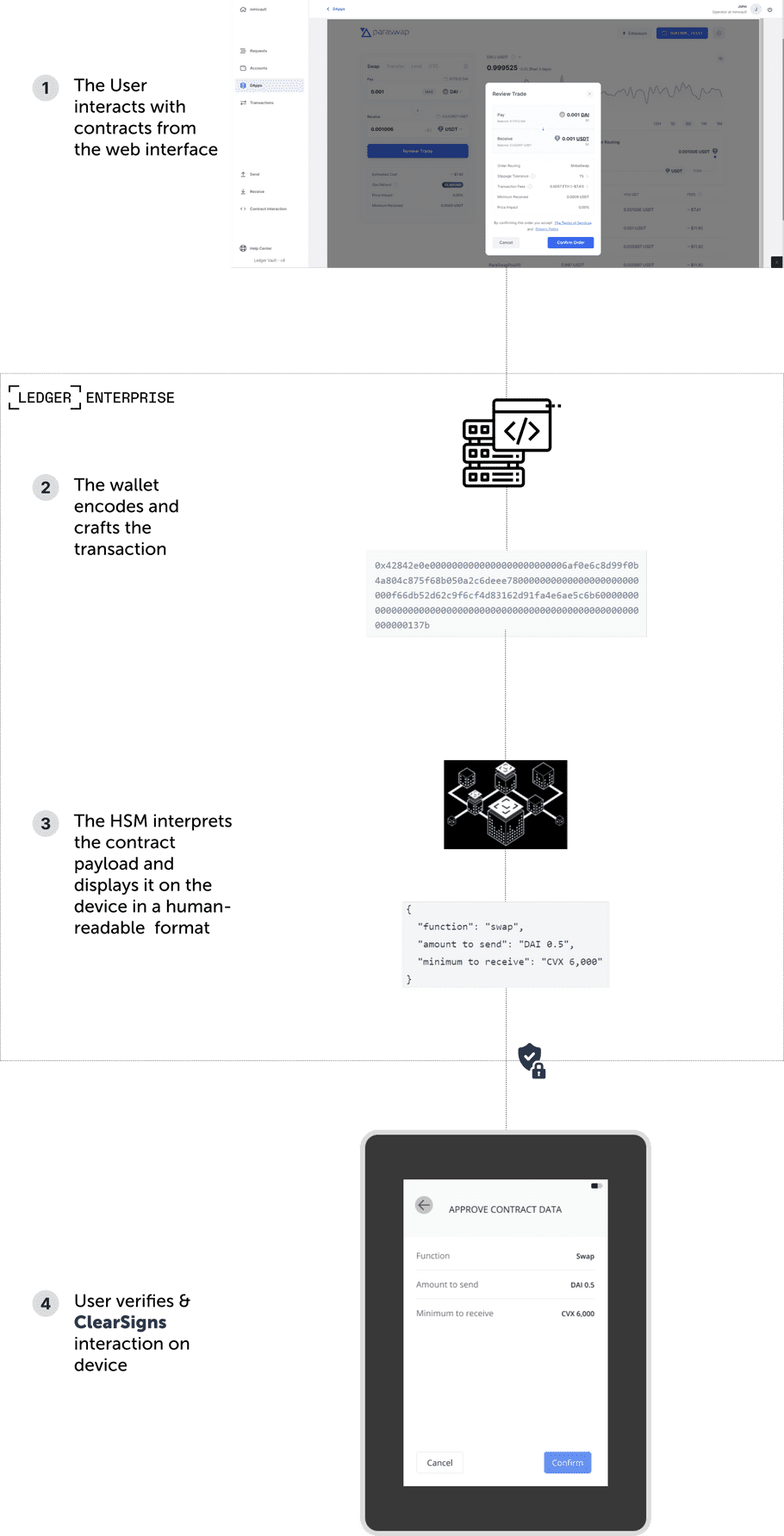
Whenever interacting with contracts supported by Ledger Enterprise ClearSign feature, Operators will be prompted to review the transaction details on device:
- 1st screen - General transaction information: as per any Ethereum transactions, Operators can review recipient data (contract name & address), account, ETH amount, fees;
- 2nd screen - Contract data: This second screen lets Operators verify the content of their contract interaction.
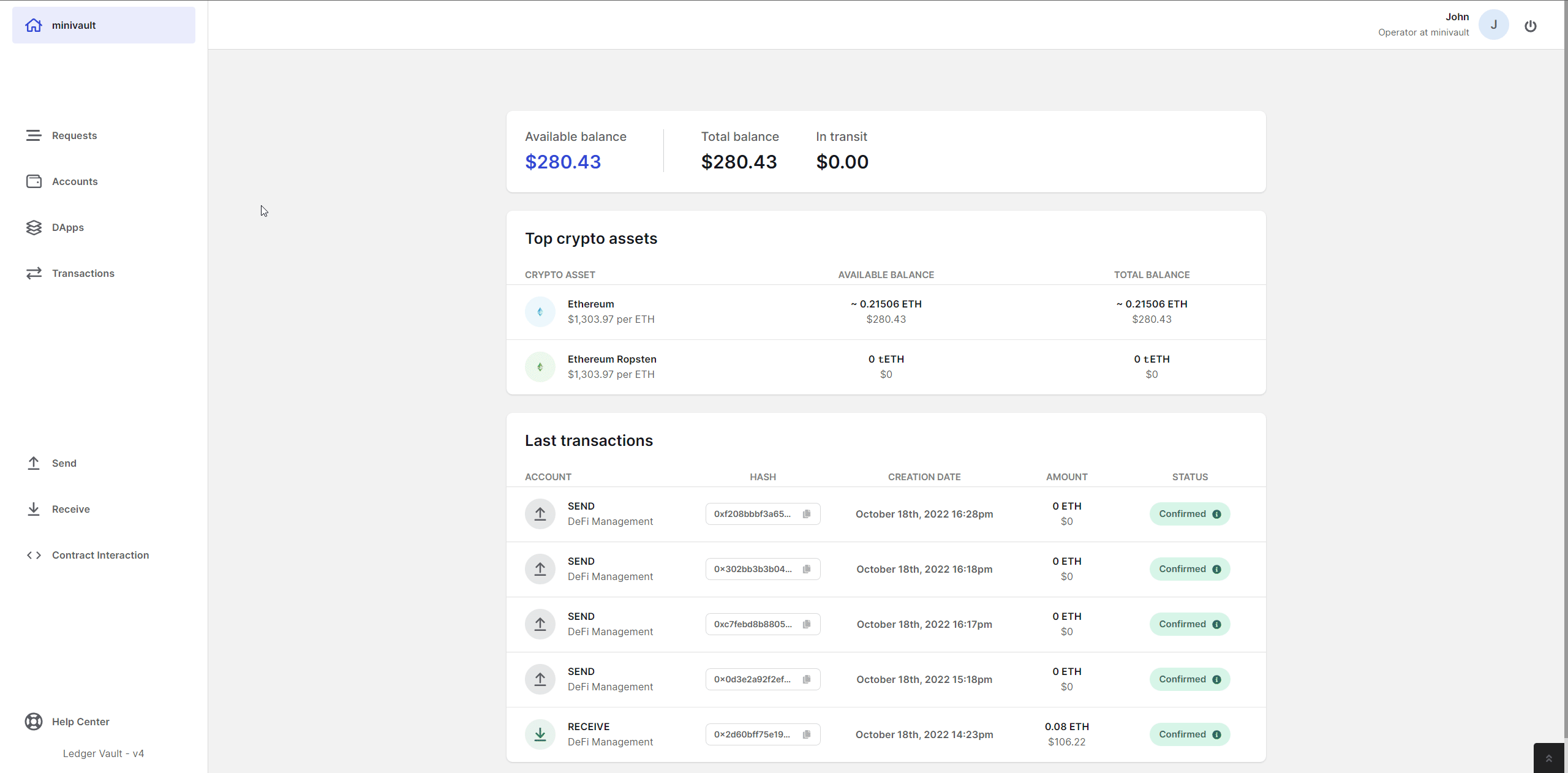
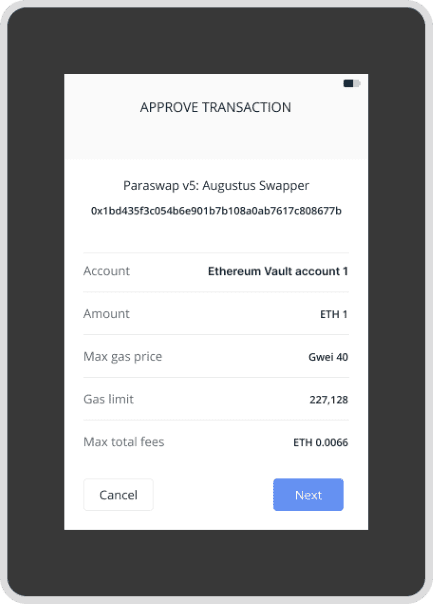
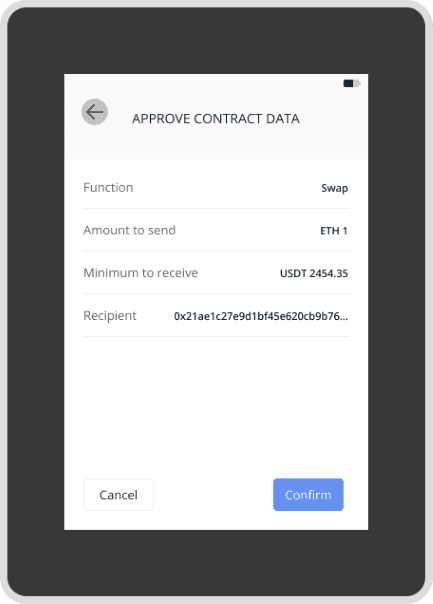
An example of a Clear-Signed transaction on Paraswap
Ledger Enterprise currently supports Paraswap’s and Lido’s contracts. When interacting with another contract, Operators will be prompted to blind-sign their transactions. You can identify blind-signed interactions with the following warning on your PSD: “Contract data cannot be displayed”. Please make sure that you trust the contract you are interacting with when blind-signing.

An example of a Blind-Signed transaction on a smart contract
In the coming months, we will extend our ClearSign contract coverage to all major DApps & contracts of the web3 ecosystem. Should you want Ledger Enterprise to support a specific application or contract, please reach out to your Technical Account Manager and we will make sure to prioritize accordingly.
Contract Interaction Panel: interact with any Ethereum contract
You can already interact with Ledger Enterprise DApps to swap, stake, and visualize your NFT assets directly from the Ledger Enterprise portal. While we work to add many more DApps to our portal, we want to empower Operators to interact with any application, should admins decide to allow them to.
This is why we’re introducing our Contract Interaction Panel, which lets Ledger Enterprise Operators interact with any Ethereum contract through a standard user-friendly interface. Find out more information here.
Please keep in mind that contract interactions are risky and may lead to loss of funds. Only interact with contracts which you understand and trust.
Improved Contract Interaction Reporting
You can now monitor your history of smart contract interactions with more accuracy. Ledger Enterprise records the contract functions and arguments which were executed on-chain, and exposes them to all available reporting tools: transaction history, csv & API exports.
Polygon Send and Receive is now available

You can now create Polygon (MATIC) accounts in your Ledger Vault workspace to send and receive funds. Polygon brings to 17 our list of supported crypto assets and over 5,000 ERC20 tokens.
We’ll be adding the possibility of conducting smart contract interactions on the Polygon network in a future release.
- Creating a Polygon account and transaction is similar to any other crypto asset. Follow the instructions on Create an account and Create a transaction for more information.
Polkadot Network Update
The Polkadot Network regularly implements updates. These changes in the transaction format need to be reflected in our different components. To take the last referendum into account (which you can see here), a fix has been made.
The technical detail of what the referendum has changed on the Polkadot blockchain is as follows:
- Polkadot transaction version bumped to 14
- Westend transaction version bumped to 12
- Every “raw address” field changed into “account lookup id” fields
October 2022 - Version 4.8.0
October 2022 - Version 4.8.0
HSM improvements
We carried out small internal improvements to strengthen the stability of the HSM ecosystem.
September 2022 - API update version 1.5.0
September 2022 - API update version 1.5.0
Estimate fees via our API
The Ledger Enterprise API now lets you estimate transaction fees before you initiate a transaction request. API operators can assess the maximum fees required for their desired transaction attributes and speed, using our new transaction fee endpoint. See our API documentation and transaction fee documentation for details.
Note that an update of the Ledger Authentication Module (LAM) to the latest image version (1.5.0) is required to estimate transaction fees with the Ledger Enterprise API. See Step 3 of the LAM installation process.
September 2022 - Version 4.7.0
September 2022 - Version 4.7.0
Solana Send and Receive is now available
You can now create Solana (SOL) accounts in your Ledger Vault workspace to send and receive funds. The integration of the Solana cryptocurrency brings our list of supported coins to 16.
Please note that we’ll add the possibility to stake your SOL to earn staking rewards in a future release.
- Creating a Solana account and transaction is similar to interacting with any other crypto asset on the LE platform. You can follow the instructions in the Create an account and Create a transaction articles for more information.
- As required by the Solana network, a minimum amount of SOL is required to keep in your account as a rent deposit. Otherwise, the account becomes eligible for deletion and will eventually be deleted. Ledger automatically ensures your accounts are exempt from paying rent, by not including this rent deposit in the available balance displayed on the account.
- With this release you will have access to the mainnet, devnet and testnet. You can select the type when creating an account. Please only use the devnet and testnet for testing purposes.
- As of today, the SOLANA chain is still experiencing some downtime. If you experience slowdown while broadcasting your transactions you can verify solana chain status online. Ledger Enterprise is not responsible for possible chain instability.
September 2022 - Ethereum Staking with Kiln
September 2022 - Ethereum Staking with Kiln
Staking Ethereum on the Ledger Enterprise platform in partnership with Kiln
Since September 22, 2022 the Ethereum protocol has fully transitioned from a Proof-of-Work to a Proof-of-Stake consensus mechanism. The implementation of a Proof-of-Stake consensus mechanism can vary widely depending on the different networks (see Polkadot staking). On Ethereum, staking is implemented via a Deposit smart contract and Validators. Staking is the act of depositing 32 ETH to the Deposit contract in order to activate a validator node. This will enable you to contribute to the security of the network, and to earn rewards.
The benefits of Ethereum staking are:
- High yield : Ethereum is the largest smart-contract blockchain by market cap and developer activity. However, only about 11% of the ETH supply is currently staked, in contrast with 50-80% on other PoS blockchains. This means that rewards are significant, and stakers should expect an APY of at least 5% under current market conditions. You can find more information on Ethereum staking rewards here .
- Low risk : so far, only 0.36% of validators have been slashed. Slashing is considered to be a rare event, and should only affect validators who misbehave deliberately. As long as the validator is participating for at least 50% of the time, they will not lose their stake.
- Simplicity : unlike other networks where staking requires a more complex set up and a suite of operations, such as Polkadot, staking on Ethereum is straightforward and can be managed easily. Thanks to our unique staking offering in partnership with Kiln, Ledger Enterprise provides an easy-to-use, 2-click feature that lets you earn yield on your Ether while remaining in control of your assets and with security and peace of mind.
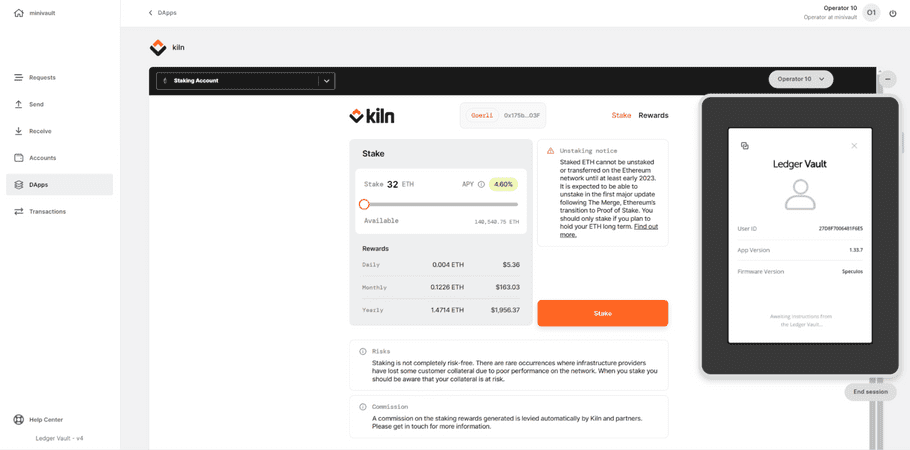
September 2022 - Version 4.6.0
September 2022 - Version 4.6.0
Polkadot Staking
We're excited to announce that it is now possible to conduct Polkadot staking operations directly on the Ledger Enterprise platform.

The benefits of staking Polkadot are:
-
Best rewards vs market cap
The Polkadot blockchain has reliably been in the Top 10/20 coins in terms of market cap and has an APY (annual percentage yield) of 13-16% since its inception, making it one of the most profitable stakable assets since 2020.
-
Low risk, high yield
Compared to other blockchains, there is a low risk of slashing when staking DOT. The main risk is missing out on staking rewards in case of poor validator performance which is statistical and should be linearised over time.
Ledger is partnering with Figment to offer an institutional-grade Polkadot staking service.
-
A unique automated staking
Polkadot is a blockchain that necessitates regular action from the token holder to nominate validators and maximise the rewards one can get. The unique partnering between Ledger and Figment allows us to automate the most cumbersome part of staking with Polkadot giving our user the assurance that we will have a reduced risk of not getting rewards and freeing them valuable time.
You can read all about how it works and how to get started here: Staking Polkadot with the Ledger Vault.
API and smart contract interactions
The Ledger Enterprise API now lets you interact with any smart contract on the Ethereum blockchain. The transaction creation & approval endpoints make it possible to trade on decentralized exchanges, deposit liquidity on DeFi protocols, mint or transfer NFTs programmatically and at scale, all while using Vault Ethereum accounts.
A new field now lets API operators add smart contract data to their API transaction creation requests (see our API documentation). Such API requests will trigger the creation of a smart contract interaction transaction, which will follow the account’s smart contract governance rule. Note that an update of the Ledger Authentication Module (LAM) to the latest image version (1.4.2) is required to perform smart contract interactions with the Ledger Enterprise API. See Step 3 of the LAM installation process: Get started with the Ledger Vault's API.
For more information on how to conduct smart contract interactions on the Ledger Enterprise platform see this article: Smart Contract Interactions on the Vault.
September 2022 - Version 4.5.0
September 2022 - Version 4.5.0
Bitcoin Native Segwit
It is now no longer possible to create Bitcoin accounts with a legacy address. But most importantly:
- We still support bitcoin legacy accounts that had already been created
- From now on administrators can only create Bitcoin Native Segwit accounts
Background changes
We pushed some hidden changes to lay the groundwork for several upcoming features.
August 2022 - Version 4.4.0
August 2022 - Version 4.4.0
HSM Counter optimization
We improved the scaling of monotonic counters on the HSM clusters. These counters allow us to scale the number of users and accounts for all customers more effectively.
August 2022 - Version 4.3.0
August 2022 - Version 4.3.0
New webhook notifications: workspace management events
-
To help you monitor and optimize your operations beyond crypto transactions, we've extended webhook notifications to new event types on Ledger Vault. The Ledger Vault API can now notify you about all requests and events related to the
management of your workspace
:
- When you create or edit accounts & entities
- When you add or revoke users & groups
- When you create or edit whitelists
- Find more information on notifications in our API guidelines here: API documentation
July 2022 - Version 4.2.0
July 2022 - Version 4.2.0
Geo-replication of the HSM Cluster
We improved the resilience and business continuity of the Vault production Cluster by replicating the HSMs of the Cluster on another datacenter. This is the first phase of the Geo-replication of the Vault HSM Cluster.
July 2022 - Version 4.1.0
July 2022 - Version 4.1.0
API and smart contract interactions
We're currently working on supporting smart contract interactions via our API. To that end, a few small changes have been made under the curtain.
July 2022 - Version 4.0.0!
July 2022 - Version 4.0.0!
The fourth version of the Vault is here! We’re always looking for new ways to increase the fool-proof security coverage of our service and this version is no exception. After having successfully hosted all our clients on the HSM cluster, we’re proud to announce that all new secure channels now use the Noise Protocol framework.
What does this mean?
All new secure channels are now based on the Noise Protocol Framework. This latter provides various handshakes patterns leading to an end-to-end encrypted data exchange, providing guarantees of confidentiality, integrity and authenticity.
The new secure channel framework relies now on three secure channels:
- One for the device registration
- One for the seed provisioning
- One for ciphering screens for the PSD
Each secure channel uses a different handshake pattern depending on the goal:
-
Device registration: two-way handshake NN pattern
- The handshake includes an attested ephemeral key to ensure that the PSD is an authentic one
- Stores a long-term key (partition key) in the PSD, which authenticates the partition
-
Seed provisioning : two-way handshake KK pattern
- In the following handshake pattern both parties have pre-knowledge of the other's static public key
-
Ciphering screens for the PSD: one-way handshake K pattern
- Takes advantage of the Out-of-order transport messages of the Noise Protocol Framework
- Each screen is encrypted individually with a nonce, which is incremented between each screen
- The data sent by the HSM includes {nonce, encrypted payload} repeated as many times as there are screens.
- This nonce is used to identify screens and to authenticate and decrypt the data received by the PSD.
Thanks to the new secure channels the following is added:
- A partition public key is now stored by the PSD. This ensures that the PSD is interacting with the correct partition, and that a partition can only be addressed by a PSD having the correct key. And therefore avoiding a PSD from switching to another partition.
- A new key is now stored by the PSD. This guarantees that the device is the PSD that was enrolled and used for mutual authentication.
Upon your first login following this release, you’ll be able to check your partition ID in the pairing section of your device. You can find out more details here: Device pairing: View your partition ID
This update requires all users necessary to approve to be up to date prior to performing the transaction, otherwise those which haven’t updated won’t be able to receive the requests. If you're an administrator, you can follow the device version of the users here: View the device version of users
June 2022 - Version 3.12.0
June 2022 - Version 3.12.0
Several new features are being released!
Entities
Entities are useful to organize accounts based on your needs – whether it's to sort accounts per currency or group the accounts of a given client. This feature allows administrators to have an easy way to display the balances of each grouping of accounts. You can find it at the top of the Accounts page.

For more information, please check the articles on the Entity feature here: Using the Entity feature
Whitelist a destination tag for XRP addresses
You will now be able to add the destination tag to an XRP address in a whitelist. You can add up to three destination tags per XRP address in the whitelist.
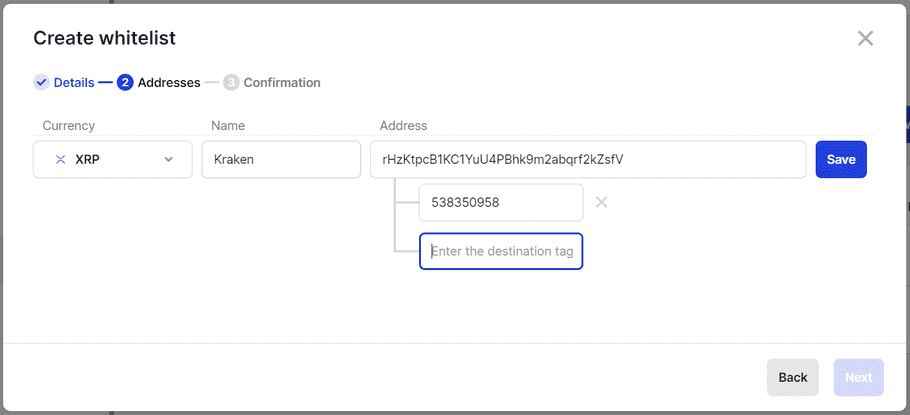
Need help creating a whitelist? Read this article: Create a whitelist
Optimizing the Success of Ethereum Transactions
Due to the fluctuations in the gas price between the date of creation of a transaction and the date of submission after all the approvals have been collected, some transactions would stay stuck or even fail because the max fees chosen ended up being too low at the moment where the transaction is submitted.
To solve this, the platform now automatically adds a buffer to the max gas price for ETH and ERC20 transactions. If you do not wish to have this buffer you can switch to the custom mode.
It’s important to distinguish the gas price from the max gas price. The amount of the gas price is what you need to pay at a given moment in order for your transaction to be broadcasted in a given amount of time. The max gas price is not necessarily what you will end up paying. It is simply a limit which maximizes your transaction success on the blockchain.
You can find more information here: Transactions
May 2022 - Version 3.11.0
May 2022 - Version 3.11.0
Polkadot Send & Receive now integrated
You can now create Polkadot (DOT) accounts in your Ledger Vault workspace to send and receive funds. Polkadot brings to 15 our list of supported crypto assets and over 4,500 ERC20 tokens.
Note that we’ll add the possibility to stake your polkadot to earn staking rewards in a future release.
- Creating a Polkadot account and transaction is similar to any other crypto asset. Follow the instructions on Create an account and Create a transaction for more information.
- As required by the Polkadot network, a minimum amount of 1 DOT is to keep in your account as an existential deposit or your account won’t be accessible by explorers. This will affect the available balance displayed.
April 2022 - Version 3.10.0
April 2022 - Version 3.10.0
Staking Tezos with Ledger Vault and Skillz
This feature is currently on trial. It is only available on demand. Please contact your Technical Account Manager for more information
You can now “stake” your Tezos holdings directly from the Ledger Vault platform and earn a percentage-rate reward over time.
- You can stake directly your Tezos funds from the platform in a few easy steps. You remain in complete control of the process and your assets.
- You can enforce dedicated governance rules for your staking transactions. Operators review and validate staking transactions on trusted devices.
For more information on the steps to activate the delegation, see here: Staking Tezos with the Ledger Vault
April 2022 - Version 3.9.0
April 2022 - Version 3.9.0
HSM Cluster
- Deployment of a new version of the operating system for the firmware embedded in all Ledger Hardware Wallets
April 2022 - Version 3.8.0
April 2022 - Version 3.8.0
Ethereum Smart contract interactions: introducing Vault DApps
This feature is currently on trial. It is only available on demand. Please contact your Technical Account Manager for more information
- Smart contracts are autonomous programs running on the Ethereum Blockchain. User accounts can interact with a smart contract by submitting transactions that execute a function defined on the smart contract. Smart contracts are the technology underlying DeFi (decentralized finance) protocols and DApps (decentralized applications), bringing “traditional” financial instruments into the crypto ecosystem. DApps operate without human intervention and are not owned by any entity. They let users lend, borrow, trade, and stake their assets in a decentralized fashion, and open up broad opportunities to generate yield and revenue.
-
Smart contract interactions are sensitive operations that can put funds at risk. Ledger Vault offers institutions the highest security standard and a robust and flexible governance framework to unlock the full potential of DApps:
- Interact with Vault DApps without leaving the safe perimeter of the platform
- Enforce dedicated governance rules for DApp interactions
- Empower users to review and validate their critical transactions on trusted hardware
- Administrators can now define a smart contract interaction governance rule on Ethereum accounts. This rule governs interactions with Vault DApps through the use of whitelists, amount thresholds, and approval steps.
-
Operators
can access Vault DApps directly from their Vault workspace, without being redirected to an external page. Vault Dapps currently features:
- Paraswap aggregates more than 20 decentralized exchanges in a single interface, so you can trade Ethereum tokens at the best possible rates.
- Lido lets you stake any amount of ETH and earn daily staking rewards. You can put your staked ETH to work across DeFi to compound your yield
- Rainbow helps you keep track of your NFT portfolio
- Vault DApps provide Vault users a single window to the Ethereum ecosystem coupled with the highest level of governance and security.
- Discover more about how this new feature works here .
February 2022 - Version 3.7.0
February 2022 - Version 3.7.0
Tezos send & receive now supported
This feature is currently available on demand. Please contact your Technical Account Manager for more information.
- You can now create Tezos (XTZ) accounts in your Ledger Vault workspace to send and receive funds. Tezos brings to 14 our list of supported crypto assets and over 4,500 ERC20 tokens.
- Note that we’ll add the possibility to delegate Tezos accounts to earn staking rewards in a future release.
- Creating a Tezos account and transaction is similar to any other crypto asset. Follow the instructions on Create an account and Create a transaction for more information.
- As required by the Tezos network, a reveal transaction will automatically be created by the Ledger Vault along with the first transaction created in the account. This transaction makes the public address of your new Tezos account known to the network.
- Once you create your first transaction, you’ll notice that a reveal transaction entry is created in the Last transaction table. This transaction is free (0XTZ), only the transaction fees are charged (about 0.0025XTZ).
Limitation
- Be aware that if you create multiple transactions at a time in a newly created Tezos account, the first one needs to be approved first to ensure the reveal transaction is created. In the meantime, any other pending transactions in this account will be put on hold. They’ll automatically be broadcasted to the blockchain once the first transaction is confirmed.
February 2022 - Version 3.6.7
February 2022 - Version 3.6.7
Miscellaneous improvements
- Improved the migration assistant stability to ensure you can complete the process smoothly.
- General user interface improvements and fixes.
- Wording has been updated to refer to your device as a Personal Security Device (PSD) in the interface and the Help Center. The term Ledger Blue Enterprise will no longer be used.